Zircon U-Pb Dating and Petrogenesis of Multiple Episodes of Anatexis in the North Dabie Complex Zone, Central China
Abstract
1. Introduction
2. Geological Setting and Samples
2.1. The North Dabie Complex Zone
2.2. Stromatic Migmatites and Leucosome Samples
2.2.1. Garnet-Bearing Leucosomes
2.2.2. Amphibole-Rich, Amphibole-Poor and K-Feldspar-Rich Leucosomes
2.2.3. Sample Description
3. Analytical Methods
3.1. Whole-Rock Major and Trace Element Analysis
3.2. Zircon U-Pb Dating
3.3. Whole-Rock Rb–Sr, Sm–Nd and Pb Isotope Analyses
3.4. Mineral Composition Analysis
4. Results
4.1. Whole-Rock Major and Trace Elements
4.2. Zircon CL Images and U-Pb Dating
4.3. Whole-Rock Rb–Sr, Sm–Nd and Pb Isotopes
5. Discussion
5.1. Mechanism of Anatexis for the Different Generations of Leucosomes
5.1.1. Fluid-Absent Decompression Melting
5.1.2. Fluid-Fluxed Melting
5.2. Ages of the Different Generations of Leucosomes
5.3. Genesis and Elemental-Isotopic Behaviour of Leucosomes.
6. Conclusions
Supplementary Materials
Author Contributions
Funding
Acknowledgments
Conflicts of Interest
References
- Hollister, L.S. The role of melt in the uplift and exhumation of orogenic belts. Chem. Geol. 1993, 108, 31–48. [Google Scholar] [CrossRef]
- Whitney, D.L.; Teyssier, C.; Rey, P. The consequences of crustal melting in continental subduction. Lithosphere 2009, 1, 323–327. [Google Scholar] [CrossRef]
- Brown, M. The generation, segregation, ascent and emplacement of granite magma: The migmatite-to-crustally-derived granite connection in thickened orogens. Earth-Sci. Rev. 1994, 36, 83–130. [Google Scholar] [CrossRef]
- Dobretsov, N.L.; Shatsky, V.S. Exhumation of high-pressure rocks of the Kokchetav massif: Facts and models. Lithos 2004, 78, 307–318. [Google Scholar] [CrossRef]
- Liu, Y.-C.; Deng, L.; Gu, X. Multistage exhumation and partial melting of high-T ultrahigh-pressure metamorphic rocks in continental subduction-collision zones. Sci. China Earth Sci. 2015, 58, 1084–1099. [Google Scholar] [CrossRef]
- Rey, P.; Vanderhaeghe, O.; Teyssier, C. Gravitational collapse of the continental crust: Definition, regimes and modes. Tectonophysics 2001, 342, 435–449. [Google Scholar] [CrossRef]
- Vanderhaeghe, O.; Teyssier, C. Partial melting and flow of orogens. Tectonophysics 2001, 342, 451–472. [Google Scholar] [CrossRef]
- Huw Davies, J.; von Blanckenburg, F. Slab breakoff: A model of lithosphere detachment and its test in the magmatism and deformation of collisional orogens. Earth Planet. Sci. Lett. 1995, 129, 85–102. [Google Scholar] [CrossRef]
- Dewey, J.F. Extensional collapse of orogens. Tectonics 1988, 7, 1123–1139. [Google Scholar] [CrossRef]
- England, P.C.; Thompson, A.B. Pressure—Temperature—Time Paths of Regional Metamorphism I. Heat Transfer during the Evolution of Regions of Thickened Continental Crust. J. Petrol. 1984, 25, 894–928. [Google Scholar] [CrossRef]
- Gao, S.; Rudnick, R.L.; Yuan, H.-L.; Liu, X.-M.; Liu, Y.-S.; Xu, W.-L.; Ling, W.-L.; Ayers, J.; Wang, X.-C.; Wang, Q.-H. Recycling lower continental crust in the North China craton. Nature 2004, 432, 892–897. [Google Scholar] [CrossRef] [PubMed]
- Huppert, H.E.; Sparks, R.S.J. The Generation of Granitic Magmas by Intrusion of Basalt into Continental Crust. J. Petrol. 1988, 29, 599–624. [Google Scholar] [CrossRef]
- Turner, S.; Arnaud, N.; Liu, J.; Rogers, N.; Hawkesworth, C.; Harris, N.; Kelley, S.; Van Calsteren, P.; Deng, W. Post-collision, Shoshonitic Volcanism on the Tibetan Plateau: Implications for Convective Thinning of the Lithosphere and the Source of Ocean Island Basalts. J. Petrol. 1996, 37, 45–71. [Google Scholar] [CrossRef]
- Arzi, A.A. Critical phenomena in the rheology of partially melted rocks. Tectonophysics 1978, 44, 173–184. [Google Scholar] [CrossRef]
- Holyoke, C.W., III; Rushmer, T. An experimental study of grain scale melt segregation mechanisms in two common crustal rock types. J. Metamorph. Geol. 2002, 20, 493–512. [Google Scholar] [CrossRef]
- Rosengerg, C.L.; Handy, M.R. Experimental deformation of partially melted granite revisited: Implications for the continental crust. J. Metamorph. Geol. 2005, 23, 19–28. [Google Scholar] [CrossRef]
- Vanderhaeghe, O. Migmatites, granites and orogeny: Flow modes of partially-molten rocks and magmas associated with melt/solid segregation in orogenic belts. Tectonophysics 2009, 477, 119–134. [Google Scholar] [CrossRef]
- Hermann, J.; Rubatto, D.; Korsakov, A.; Shatsky, V.S. Multiple zircon growth during fast exhumation of diamondiferous, deeply subducted continental crust (Kokchetav Massif, Kazakhstan). Contrib. Mineral. Petrol. 2001, 141, 66–82. [Google Scholar] [CrossRef]
- Jamieson, R.A.; Unsworth, M.J.; Harris, N.B.W.; Rosenberg, C.L.; Schulmann, K. Crustal Melting and the Flow of Mountains. Elements 2011, 7, 253–260. [Google Scholar] [CrossRef]
- Labrousse, L.; Prouteau, G.; Ganzhorn, A.-C. Continental exhumation triggered by partial melting at ultrahigh pressure. Geology 2011, 39, 1171–1174. [Google Scholar] [CrossRef]
- Wallis, S.; Tsuboi, M.; Suzuki, K.; Fanning, M.; Jiang, L.; Tanaka, T. Role of partial melting in the evolution of the Sulu (eastern China) ultrahigh-pressure terrane. Geology 2005, 33, 129–132. [Google Scholar] [CrossRef]
- Barraud, J.; Gardien, V.; Allemand, P.; Grandjean, P. Analogue models of melt-flow networks in folding migmatites. J. Struct. Geol. 2004, 26, 307–324. [Google Scholar] [CrossRef]
- Hinchey, A.M.; Carr, S.D.; McNeill, P.D.; Rayner, N. Paleocene–Eocene high-grade metamorphism, anatexis, and deformation in the Thor–Odin dome, Monashee complex, southeastern British Columbia. Can. J. Earth Sci. 2006, 43, 1341–1365. [Google Scholar] [CrossRef]
- Auzanneau, E.; Vielzeuf, D.; Schmidt, M.W. Experimental evidence of decompression melting during exhumation of subducted continental crust. Contrib. Mineral. Petrol. 2006, 152, 125–148. [Google Scholar] [CrossRef]
- Büsch, W.; Schenider, G.; Mehnert, K. Initial melting at grain boundaries. Part II: Melting in rocks of granodioritic, quartzdioritic and tonalitic composition. Neues Jahrb. Mineral. Mon. 1974, 8, 345–370. [Google Scholar]
- Perchuk, A.L.; Burchard, M.; Maresch, W.V.; Schertl, H.-P. Fluid-mediated modification of garnet interiors under ultrahigh-pressure conditions. Terra Nova 2005, 17, 545–553. [Google Scholar] [CrossRef]
- Del Moro, A.; Fornelli, A.; Piccarreta, G. Disequilibrium melting in granulite-facies metasedimentary rocks of the Northern Serre (Calabria-Southern Italy). Mineral. Petrol. 2000, 70, 89–104. [Google Scholar] [CrossRef]
- Liu, Y.-C.; Li, S.-G.; Gu, X.-F.; Xu, S.-T.; Chen, G.-B. Ultrahigh-pressure eclogite transformed from mafic granulite in the Dabie orogen, east-central China. J. Metamorph. Geol. 2007, 25, 975–989. [Google Scholar] [CrossRef]
- Liu, Y.-C.; Li, S.-G.; Xu, S.-T. Zircon SHRIMP U–Pb dating for gneisses in northern Dabie high T/P metamorphic zone, central China: Implications for decoupling within subducted continental crust. Lithos 2007, 96, 170–185. [Google Scholar] [CrossRef]
- Liu, Y.-C.; Deng, L.-P.; Gu, X.-F.; Groppo, C.; Rolfo, F. Application of Ti-in-zircon and Zr-in-rutile thermometers to constrain high-temperature metamorphism in eclogites from the Dabie orogen, central China. Gondwana Res. 2015, 27, 410–423. [Google Scholar] [CrossRef]
- Hacker, B.R.; Ratschbacher, L.; Webb, L.; Ireland, T.; Walker, D.; Shuwen, D. U/Pb zircon ages constrain the architecture of the ultrahigh-pressure Qinling–Dabie Orogen, China. Earth Planet. Sci. Lett. 1998, 161, 215–230. [Google Scholar] [CrossRef]
- Wang, J.; Sun, M.; Deng, S. Geochronological constraints on the timing of migmatization in the Dabie Shan, East-central China. Eur. J. Mineral. 2002, 14, 513–524. [Google Scholar] [CrossRef]
- Faure, M.; Lin, W.; Schärer, U.; Shu, L.; Sun, Y.; Arnaud, N. Continental subduction and exhumation of UHP rocks. Structural and geochronological insights from the Dabieshan (East China). Lithos 2003, 70, 213–241. [Google Scholar] [CrossRef]
- Wu, Y.-B.; Zheng, Y.-F.; Zhang, S.-B.; Zhao, Z.-F.; Wu, F.-Y.; Liu, X.-M. Zircon U–Pb ages and Hf isotope compositions of migmatite from the North Dabie terrane in China: Constraints on partial melting. J. Metamorph. Geol. 2007, 25, 991–1009. [Google Scholar] [CrossRef]
- Wang, S.-J.; Li, S.-G.; Chen, L.-J.; He, Y.-S.; An, S.-C.; Shen, J. Geochronology and geochemistry of leucosomes in the North Dabie Terrane, East China: Implication for post-UHPM crustal melting during exhumation. Contrib. Mineral. Petrol. 2013, 165, 1009–1029. [Google Scholar] [CrossRef]
- Chen, R.-X.; Ding, B.; Zheng, Y.-F.; Hu, Z. Multiple episodes of anatexis in a collisional orogen: Zircon evidence from migmatite in the Dabie orogen. Lithos 2015, 212–215, 247–265. [Google Scholar] [CrossRef]
- Hu, Z.-P.; Zhang, Y.-S.; Hu, R.; Wang, J.; Siebel, W.; Chen, F. Amphibole-bearing migmatite in North Dabie, eastern China: Water-fluxed melting of the orogenic crust. J. Asian Earth Sci. 2016, 125, 100–116. [Google Scholar] [CrossRef]
- Xu, H.; Zhang, J. Anatexis witnessed post-collisional evolution of the Dabie orogen, China. J. Asian Earth Sci. 2017, 145, 278–296. [Google Scholar] [CrossRef]
- He, Y.; Li, S.; Hoefs, J.; Huang, F.; Liu, S.-A.; Hou, Z. Post-collisional granitoids from the Dabie orogen: New evidence for partial melting of a thickened continental crust. Geochim. Et Cosmochim. Acta 2011, 75, 3815–3838. [Google Scholar] [CrossRef]
- Deng, L.-P.; Liu, Y.-C.; Gu, X.-F.; Groppo, C.; Rolfo, F. Partial melting of ultrahigh-pressure metamorphic rocks at convergent continental margins: Evidences, melt compositions and physical effects. Geosci. Front. 2018, 9, 1229–1242. [Google Scholar] [CrossRef]
- Deng, L.-P.; Liu, Y.-C.; Yang, Y.; Groppo, C.; Rolfo, F.; Gu, X.-F. Anatexis of high-T eclogites in the Dabie orogen triggered by exhumation and post-orogenic collapse. Eur. J. Mineral. 2019, 31, 889–903. [Google Scholar] [CrossRef]
- Li, Y.; Yang, Y.; Liu, Y.-C.; Groppo, C.; Rolfo, F. Muscovite Dehydration Melting in Silica-Undersaturated Systems: A Case Study from Corundum-Bearing Anatectic Rocks in the Dabie Orogen. Minerals 2020, 10, 213. [Google Scholar] [CrossRef]
- Li, S.; Xiao, Y.; Liou, D.; Chen, Y.; Ge, N.; Zhang, Z.; Sun, S.-S.; Cong, B.; Zhang, R.; Hart, S.R.; et al. Collision of the North China and Yangtse Blocks and formation of coesite-bearing eclogites: Timing and processes. Chem. Geol. 1993, 109, 89–111. [Google Scholar] [CrossRef]
- Xu, S.; Okay, A.I.; Ji, S.; Sengör, A.M.C.; Su, W.; Liu, Y.-C.; Jiang, L. Diamond from the Dabie Shan Metamorphic Rocks and Its Implication for Tectonic Setting. Science 1992, 256, 80–82. [Google Scholar] [CrossRef]
- Liu, Y.-C.; Li, S. Detachment within subducted continental crust and multi-slice successive exhumation of ultrahigh-pressure metamorphic rocks: Evidence from the Dabie-Sulu orogenic belt. Chin. Sci. Bull. 2008, 53, 3105–3119. [Google Scholar] [CrossRef]
- Liu, Y.-C.; Liu, L.-X.; Li, Y.; Gu, X.-F.; Song, B. Zircon U-Pb geochronology and petrogenesis of metabasites from the western Beihuaiyang zone in the Hong’an orogen, central China: Implications for detachment within subducting continental crust at shallow depths. J. Asian Earth Sci. 2017, 145, 74–90. [Google Scholar] [CrossRef]
- Xu, S.; Liu, Y.; Chen, G.; Compagnoni, R.; Rolfo, F.; He, M.; Liu, H. New finding of micro-diamonds in eclogites from Dabie-Sulu region in central-eastern China. Sci. Bull. 2003, 48, 988–994. [Google Scholar] [CrossRef]
- Xu, S.; Liu, Y.; Chen, G.; Ji, S.; Ni, P.; Xiao, W. Microdiamonds, their classification and tectonic implications for the host eclogites from the Dabie and Su-Lu regions in central eastern China. Mineral. Mag. 2005, 69, 509–520. [Google Scholar] [CrossRef]
- Groppo, C.; Rolfo, F.; Liu, Y.-C.; Deng, L.-P.; Wang, A.-D. P-T evolution of elusive UHP eclogites from the Luotian dome (North Dabie Zone, China): How far can the thermodynamic modeling lead us? Lithos 2015, 226, 183–200. [Google Scholar] [CrossRef]
- Li, X.-P.; Zheng, Y.-F.; Wu, Y.-B.; Chen, F.; Gong, B.; Li, Y.-L. Low-T eclogite in the Dabie terrane of China: Petrological and isotopic constraints on fluid activity and radiometric dating. Contrib. Mineral. Petrol. 2004, 148, 443–470. [Google Scholar] [CrossRef]
- Liu, Y.-C.; Li, S.; Xu, S.; Jahn, B.-m.; Zheng, Y.-F.; Zhang, Z.; Jiang, L.; Chen, G.; Wu, W. Geochemistry and geochronology of eclogites from the northern Dabie Mountains, central China. J. Asian Earth Sci. 2005, 25, 431–443. [Google Scholar] [CrossRef]
- Liu, Y.-C.; Gu, X.; Rolfo, F.; Chen, Z. Ultrahigh-pressure metamorphism and multistage exhumation of eclogite from the Luotian dome, North Dabie Complex Zone (central China): Evidence from mineral inclusions and decompression texture. J. Asian Earth Sci. 2011, 42, 607–617. [Google Scholar] [CrossRef]
- Okay, A.I.; Xu, S.T.; Sengor, A.M.C. Coesite from the Dabie Shan eclogites, central China. Eur. J. Mineral. 1989, 1, 595–598. [Google Scholar] [CrossRef]
- Rolfo, F.; Compagnoni, R.; Wu, W.; Xu, S. A coherent lithostratigraphic unit in the coesite–eclogite complex of Dabie Shan, China: Geologic and petrologic evidence. Lithos 2004, 73, 71–94. [Google Scholar] [CrossRef]
- Wang, X.; Liou, J.G.; Mao, H. Coesite-bearing eclogite from the Dabie Mountains in central China. Geology 1989, 17, 1085–1088. [Google Scholar] [CrossRef]
- Xu, S.; Liu, Y.; Su, W.; Wang, R.; Jiang, L.; Wu, W. Discovery of the eclogite and its petrography in the Northern Dabie Mountain. Chin. Sci. Bull. 2000, 45, 273–278. [Google Scholar] [CrossRef]
- Li, S.; Jagoutz, E.; Chen, Y.; Li, Q. Sm–Nd and Rb–Sr isotopic chronology and cooling history of ultrahigh pressure metamorphic rocks and their country rocks at Shuanghe in the Dabie Mountains, Central China. Geochim. Cosmochim. Acta 2000, 64, 1077–1093. [Google Scholar] [CrossRef]
- Liu, Y.-C.; Gu, X.-F.; Li, S.-G.; Hou, Z.-H.; Song, B. Multistage metamorphic events in granulitized eclogites from the North Dabie complex zone, central China: Evidence from zircon U–Pb age, trace element and mineral inclusion. Lithos 2011, 122, 107–121. [Google Scholar] [CrossRef]
- Malaspina, N.; Hermann, J.; Scambelluri, M.; Compagnoni, R. Multistage metasomatism in ultrahigh-pressure mafic rocks from the North Dabie Complex (China). Lithos 2006, 90, 19–42. [Google Scholar] [CrossRef]
- Li, S.G.; He, Y.S.; Wang, S.J. Process and mechanism of mountain-root removal of the Dabie Orogen Constraints from geochronology and geochemistry of post-collisional igneous rocks. Chin. Sci. Bull. 2013, 58, 4411–4417. [Google Scholar] [CrossRef]
- Sawyer, E.W. Migmatites formed by water-fluxed partial melting of a leucogranodiorite protolith: Microstructures in the residual rocks and source of the fluid. Lithos 2010, 116, 273–286. [Google Scholar] [CrossRef]
- Black, L.P.; Kamo, S.L.; Allen, C.M.; Aleinikoff, J.N.; Davis, D.W.; Korsch, R.J.; Foudoulis, C. TEMORA 1: A new zircon standard for Phanerozoic U–Pb geochronology. Chem. Geol. 2003, 200, 155–170. [Google Scholar] [CrossRef]
- Compston, W.; Williams, I.S.; Meyer, C. U-Pb geochronology of zircons from lunar breccia 73217 using a sensitive high mass-resolution ion microprobe. J. Geophys. Res. Solid Earth 1984, 89, B525–B534. [Google Scholar] [CrossRef]
- Ludwig, K.R. User’s Manual for Isoplot 3.00: A Geochronological Tookit for Microsoft Excel; Berkeley Geochronology Center Special Publication: Berkeley, CA, USA, 2003; Volume 4. [Google Scholar]
- Liu, Y.; Hu, Z.; Gao, S.; Günther, D.; Xu, J.; Gao, C.; Chen, H. In situ analysis of major and trace elements of anhydrous minerals by LA-ICP-MS without applying an internal standard. Chem. Geol. 2008, 257, 34–43. [Google Scholar] [CrossRef]
- Liu, Y.; Gao, S.; Hu, Z.; Gao, C.; Zong, K.; Wang, D. Continental and Oceanic Crust Recycling-induced Melt–Peridotite Interactions in the Trans-North China Orogen: U–Pb Dating, Hf Isotopes and Trace Elements in Zircons from Mantle Xenoliths. J. Petrol. 2009, 51, 537–571. [Google Scholar] [CrossRef]
- Chen, F.; Hegner, E.; Todt, W. Zircon ages and Nd isotopic and chemical compositions of orthogneisses from the Black Forest, Germany: Evidence for a Cambrian magmatic arc. Int. J. Earth Sci. 2000, 88, 791–802. [Google Scholar] [CrossRef]
- Chen, F.; Li, X.-H.; Wang, X.-L.; Li, Q.-L.; Siebel, W. Zircon age and Nd–Hf isotopic composition of the Yunnan Tethyan belt, southwestern China. Int. J. Earth Sci. 2007, 96, 1179–1194. [Google Scholar] [CrossRef]
- Whitney, D.L.; Evans, B.W. Abbreviations for names of rock-forming minerals. Am. Mineral. 2010, 95, 185–187. [Google Scholar] [CrossRef]
- Boynton, W.V. Geochemistry of the Rare Earth Elements: Meteorite Study. In Rare Earth Element Geochemistry; Henderson, P., Ed.; Elsevier: Amsterdam, The Netherlands, 1984; pp. 63–114. [Google Scholar]
- Sun, S.-s.; McDonough, W.F. Chemical and isotopic systematics of oceanic basalts: Implications for mantle composition and processes. Geol. Soc. 1989, 42, 313–345. [Google Scholar] [CrossRef]
- Liu, X.; Yan, J.; Yang, G. Geochronology and geochemistry of the Sikongshan intrusion in the Dabie Orogen, Central China: Implication for Mesozoic geodynamic background. Geol. J. 2020, 55, 3010–3035. [Google Scholar] [CrossRef]
- Lustrino, M.; Dallai, L. On the origin of EM–I end-member. Neues Jahrb. Mineral. Abh. 2003, 179, 85–100. [Google Scholar] [CrossRef]
- Moyen, J.F.; Stevens, G. Experimental Constraints on TTG Petrogenesis: Implications for Archean Geodynamics. Archean Geodynamics and Environments; American Geophysical Union (AGU): Washington, DC, USA, 2006. [Google Scholar]
- Clemens, J.; Watkins, J. The fluid regime of high-temperature metamorphism during granitoid magma genesis. Contrib. Mineral. Petrol. 2001, 140, 600–606. [Google Scholar] [CrossRef]
- Rutter, M.J.; Wyllie, P.J. Melting of vapour-absent tonalite at 10 kbar to simulate dehydration–melting in the deep crust. Nature 1988, 331, 159–160. [Google Scholar] [CrossRef]
- Fornelli, A.; Piccarreta, G.; Del Moro, A.; Acquafredda, P. Multi-stage Melting in the Lower Crust of the Serre (Southern Italy). J. Petrol. 2002, 43, 2191–2217. [Google Scholar] [CrossRef]
- Dahlquist, J.A.; Galindo, C.; Pankhurst, R.J.; Rapela, C.W.; Alasino, P.H.; Saavedra, J.; Fanning, C.M. Magmatic evolution of the Peñón Rosado granite: Petrogenesis of garnet-bearing granitoids. Lithos 2007, 95, 177–207. [Google Scholar] [CrossRef]
- Leake, B.E. Zoned garnets from the galway granite and its aplites. Earth Planet. Sci. Lett. 1967, 3, 311–316. [Google Scholar] [CrossRef]
- Villaros, A.; Stevens, G.; Buick, I.S. Tracking S-type granite from source to emplacement: Clues from garnet in the Cape Granite Suite. Lithos 2009, 112, 217–235. [Google Scholar] [CrossRef]
- Watson, E.B.; Harrison, T.M. Zircon saturation revisited: Temperature and composition effects in a variety of crustal magma types. Earth Planet. Sci. Lett. 1983, 64, 295–304. [Google Scholar] [CrossRef]
- Dale, J.; Holland, T.; Powell, R. Hornblende–garnet–plagioclase thermobarometry: A natural assemblage calibration of the thermodynamics of hornblende. Contrib. Mineral. Petrol. 2000, 140, 353–362. [Google Scholar] [CrossRef]
- Patino Douce, A.E.; Beard, J.S. Dehydration-melting of Biotite Gneiss and Quartz Amphibolite from 3 to 15 kbar. J. Petrol. 1995, 36, 707–738. [Google Scholar] [CrossRef]
- Patino Douce, A.E.; Beard, J.S. Effects of P, f(O2) and Mg/Fe Ratio on Dehydration Melting of Model Metagreywackes. J. Petrol. 1996, 37, 999–1024. [Google Scholar] [CrossRef]
- Weinberg, R.F.; Veveakis, E.; Regenauerlieb, K. Compaction-driven melt segregation in migmatites. Geology 2015, 43, 471–474. [Google Scholar] [CrossRef]
- Sawyer, E.W. Altas of Migmatites; NRC Research Press: Ottowa, ON, Canada, 2008; Volume 9. [Google Scholar]
- Slagstad, T.; Jamieson, R.A.; Culshaw, N.G. Formation, Crystallization, and Migration of Melt in the Mid-orogenic Crust: Muskoka Domain Migmatites, Grenville Province, Ontario. J. Petrol. 2005, 46, 893–919. [Google Scholar] [CrossRef]
- Berger, A.; Burri, T.; Alt-Epping, P.; Engi, M. Tectonically controlled fluid flow and water-assisted melting in the middle crust: An example from the Central Alps. Lithos 2008, 102, 598–615. [Google Scholar] [CrossRef]
- Cruciani, G.; Franceschelli, M.; Jung, S.; Puxeddu, M.; Utzeri, D. Amphibole-bearing migmatites from the Variscan Belt of NE Sardinia, Italy: Partial melting of mid-Ordovician igneous sources. Lithos 2008, 105, 208–224. [Google Scholar] [CrossRef]
- Aubaud, C.; Hauri, E.H.; Hirschmann, M.M. Hydrogen partition coefficients between nominally anhydrous minerals and basaltic melts. Geophys. Res. Lett. 2004, 31, L20611. [Google Scholar] [CrossRef]
- Hirschmann, M.M.; Tenner, T.; Aubaud, C.; Withers, A.C. Dehydration melting of nominally anhydrous mantle: The primacy of partitioning. Phys. Earth Planet. Inter. 2009, 176, 54–68. [Google Scholar] [CrossRef]
- Naney, M.T. Phase equilibria of rock-forming ferromagnesian silicates in granitic systems. Am. J. Sci. 1983, 283, 993–1033. [Google Scholar] [CrossRef]
- Johnston, A.D.; Wyllie, P.J. Constraints on the origin of Archean trondhjemites based on phase relationships of Nûk gneiss with H2O at 15 kbar. Contrib. Mineral. Petrol. 1988, 100, 35–46. [Google Scholar] [CrossRef]
- Skjerlie, K.P.; Johnston, A.D. Vapour-Absent Melting from 10 to 20 kbar of Crustal Rocks that Contain Multiple Hydrous Phases: Implications for Anatexis in the Deep to Very Deep Continental Crust and Active Continental Margins. J. Petrol. 1996, 37, 661–691. [Google Scholar] [CrossRef]
- Brown, M. Metamorphic patterns in orogenic systems and the geological record. Geol. Soc. 2009, 318, 37–74. [Google Scholar] [CrossRef]
- Burri, T.; Berger, A.; Engi, M. Tertiary migmatites in the central Alps: Regional distribution, field relations, conditions of formation, and tectonic implications. Schweiz. Mineral. Petrogr. Mitt. 2005, 85, 215–232. [Google Scholar]
- Mogk, D.W. Ductile shearing and migmatization at mid-crustal levels in an Archaean high-grade gneiss belt, northern Gallatin Range, Montana, USA. J. Metamorph. Geol. 1992, 10, 427–438. [Google Scholar] [CrossRef]
- Bea, F.; Pereira, M.D.; Stroh, A. Mineral/leucosome trace-element partitioning in a peraluminous migmatite (a laser ablation-ICP-MS study). Chem. Geol. 1994, 117, 291–312. [Google Scholar] [CrossRef]
- Neiva, A.M.R. Distribution of trace elements in feldspars of granitic aplites and pegmatites from Alijó-Sanfins, northern Portugal. Mineral. Mag. 1995, 59, 35–45. [Google Scholar] [CrossRef]
- Harrison, M.T.; Grove, M.; Mckeegan, K.D.; Coath, C.D.; Lovera, O.M.; Fort, P.L. Origin and Episodic Emplacement of the Manaslu Intrusive Complex, Central Himalaya. J. Petrol. 1999, 40, 3–19. [Google Scholar] [CrossRef]
- Schmidt, M.W. Amphibole composition in tonalite as a function of pressure: An experimental calibration of the Al-in-hornblende barometer. Contrib. Mineral. Petrol. 1992, 110, 304–310. [Google Scholar] [CrossRef]
- Holland, T.; Blundy, J. Non-ideal interactions in calcic amphiboles and their bearing on amphibole-plagioclase thermometry. Contrib. Mineral. Petrol. 1994, 116, 433–447. [Google Scholar] [CrossRef]
- Hermann, J.; Spandler, C.; Hack, A.; Korsakov, A.V. Aqueous fluids and hydrous melts in high-pressure and ultra-high pressure rocks: Implications for element transfer in subduction zones. Lithos 2006, 92, 399–417. [Google Scholar] [CrossRef]
- Ames, L.; Gaozhi, Z.; Baocheng, X. Geochronology and isotopic character of ultrahigh-pressure metamorphism with implications for collision of the Sino-Korean and Yangtze cratons, central China. Tectonics 1996, 15, 472–489. [Google Scholar] [CrossRef]
- Wlillams, I.S.; Buick, I.S.; Cartwright, I. An extended episode of early Mesoproterozoic metamorphic fluid flow in the Reynolds Range, central Australia. J. Metamorph. Geol. 1996, 14, 29–47. [Google Scholar] [CrossRef]
- Hoskin, P.W.O.; Schaltegger, U. The Composition of Zircon and Igneous and Metamorphic Petrogenesis. Rev. Mineral. Geochem. 2003, 53, 27–62. [Google Scholar] [CrossRef]
- Rubatto, D.; Hermann, J. Zircon formation during fluid circulation in eclogites (Monviso, Western Alps): Implications for Zr and Hf budget in subduction zones. Geochim. Cosmochim. Acta 2003, 67, 2173–2187. [Google Scholar] [CrossRef]
- Burda, J.; Gawęda, A. Shear-influenced partial melting in the Western Tatra metamorphic complex: Geochemistry and geochronology. Lithos 2009, 110, 373–385. [Google Scholar] [CrossRef]
- Reno, B.L.; Piccoli, P.M.; Brown, M.; Trouw, R.A.J. In situ monazite (U–Th)–Pb ages from the Southern Brasília Belt, Brazil: Constraints on the high-temperature retrograde evolution of HP granulites. J. Metamorph. Geol. 2012, 30, 81–112. [Google Scholar] [CrossRef]
- Brown, M.; Solar, G.S. Shear-zone systems and melts: Feedback relations and self-organization in orogenic belts. J. Struct. Geol. 1998, 20, 211–227. [Google Scholar] [CrossRef]
- Brown, M.; Solar, G.S. Granite ascent and emplacement during contractional deformation in convergent orogens. J. Struct. Geol. 1998, 20, 1365–1393. [Google Scholar] [CrossRef]
- Marchildon, N.; Brown, M. Spatial distribution of melt-bearing structures in anatectic rocks from Southern Brittany, France: Implications for melt transfer at grain- to orogen-scale. Tectonophysics 2003, 364, 215–235. [Google Scholar] [CrossRef]
- Solar, G.S.; Brown, M. Petrogenesis of Migmatites in Maine, USA: Possible Source of Peraluminous Leucogranite in Plutons? J. Petrol. 2001, 42, 789–823. [Google Scholar] [CrossRef]
- Li, Y.; Liu, Y.-C.; YANG, Y.; Deng, L. New U-Pb Geochronological Constraints on Formation and Evolution of the Susong Complex Zone in the Dabie Orogen. Acta Geol. Sin. (Engl. Ed.) 2017, 91, 1915–1918. [Google Scholar] [CrossRef]
- Li, Y.; Liu, Y.-C.; Yang, Y.; Rolfo, F.; Groppo, C. Petrogenesis and tectonic significance of Neoproterozoic meta-basites and meta-granitoids within the central Dabie UHP zone, China: Geochronological and geochemical constraints. Gondwana Res. 2020, 78, 1–19. [Google Scholar] [CrossRef]
- Shen, J.; Wang, Y.; Li, S.-G. Common Pb isotope mapping of UHP metamorphic zones in Dabie orogen, Central China: Implication for Pb isotopic structure of subducted continental crust. Geochim. Cosmochim. Acta 2014, 143, 115–131. [Google Scholar] [CrossRef]
- Ague, J.J. Evidence for major mass transfer and volume strain during regional metamorphism of pelites. Geology 1991, 19, 855–858. [Google Scholar] [CrossRef]
- Becker, H.; Jochum, K.P.; Carlson, R.W. Constraints from high-pressure veins in eclogites on the composition of hydrous fluids in subduction zones. Chem. Geol. 1999, 160, 291–308. [Google Scholar] [CrossRef]
- Ferry, J.M. Mineral reactions and element migration during metamorphism of calcareous sediments from the Vassalboro Formation, south-central Maine. Am. Mineral. 1983, 68, 334–354. [Google Scholar]
- Tang, H.F.; Liu, C.Q.; Xie, G.G. Mass transfer and element mobility of rocks during regional metamorphism: A case study of metamorphosed pelites from the Shuangqiaoshan Group in Lushan. Geol. Rev. 2000, 46, 245–254. [Google Scholar]
- Ayres, M.; Harris, N. REE fractionation and Nd-isotope disequilibrium during crustal anatexis: Constraints from Himalayan leucogranites. Chem. Geol. 1997, 139, 249–269. [Google Scholar] [CrossRef]
- Zeng, L.; Saleeby, J.B.; Asimow, P.D. Nd isotope disequilibrium during crustal anatexis: A record from the Goat Ranch migmatite complex, southern Sierra Nevada batholith, California. Geology 2005, 33, 53–56. [Google Scholar] [CrossRef]
- Beard, J.S.; Lofgren, G.E. Dehydration Melting and Water-Saturated Melting of Basaltic and Andesitic Greenstones and Amphibolites at 1, 3, and 6.9 kb. J. Petrol. 1991, 32, 365–401. [Google Scholar] [CrossRef]
- Watkins, J.M.; Clemens, J.D.; Treloar, P.J. Archaean TTGs as sources of younger granitic magmas: Melting of sodic metatonalites at 0.6–1.2 GPa. Contrib. Mineral. Petrol. 2007, 154, 91–110. [Google Scholar] [CrossRef]
- Sawyer, E.W. Criteria for the recognition of partial melting. Phys. Chem. Earthpart A Solid Earth Geod. 1999, 24, 269–279. [Google Scholar] [CrossRef]
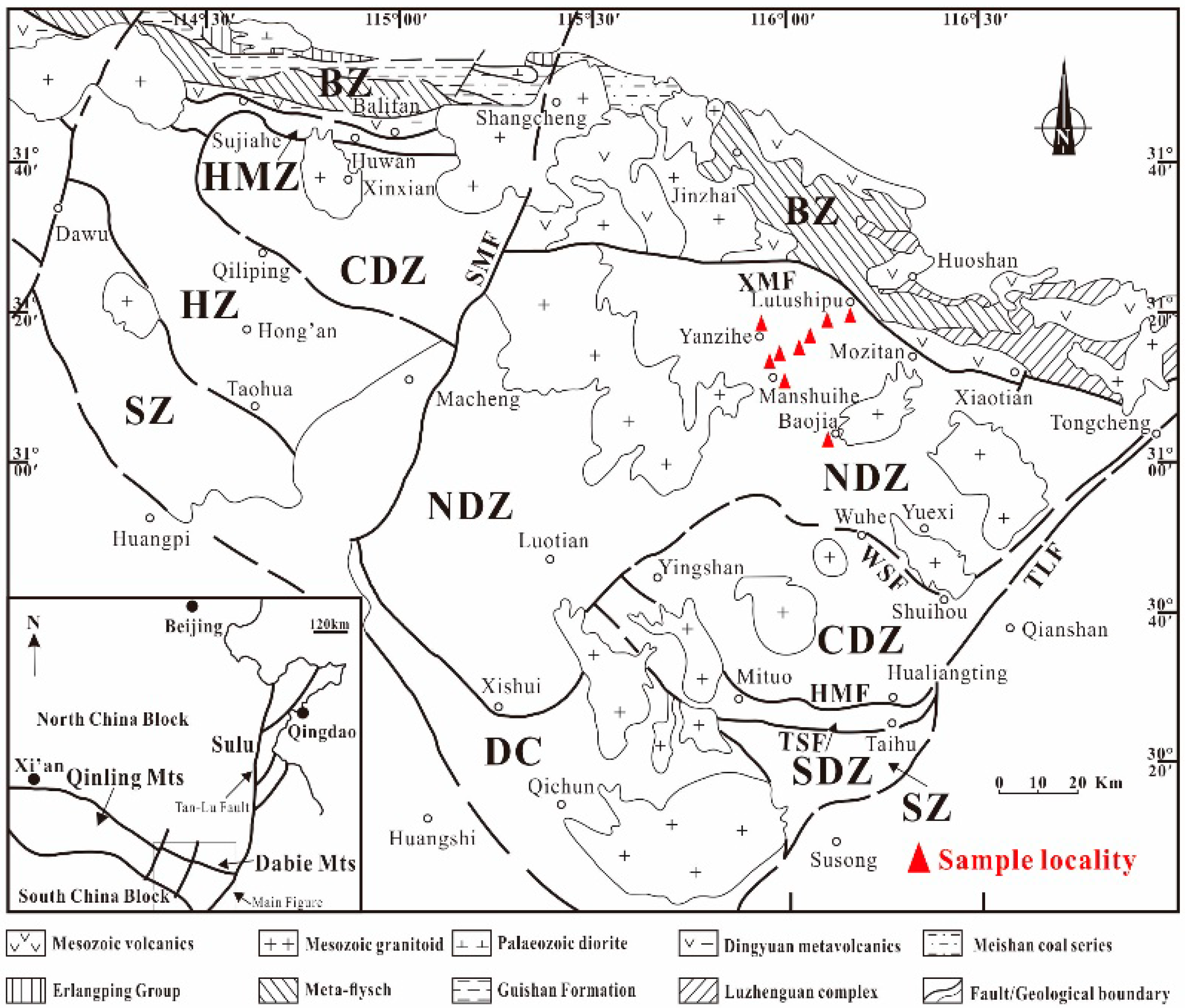
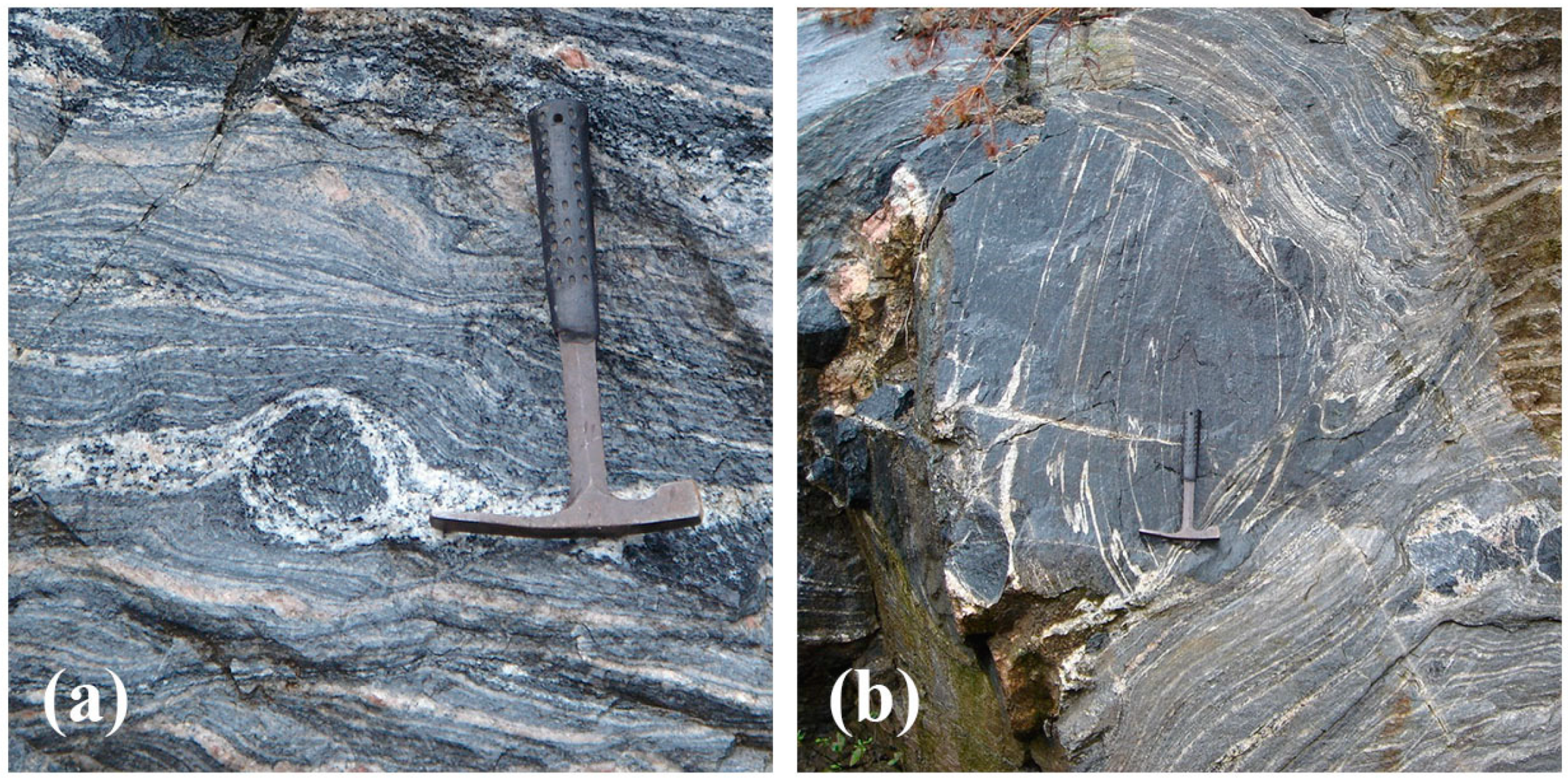
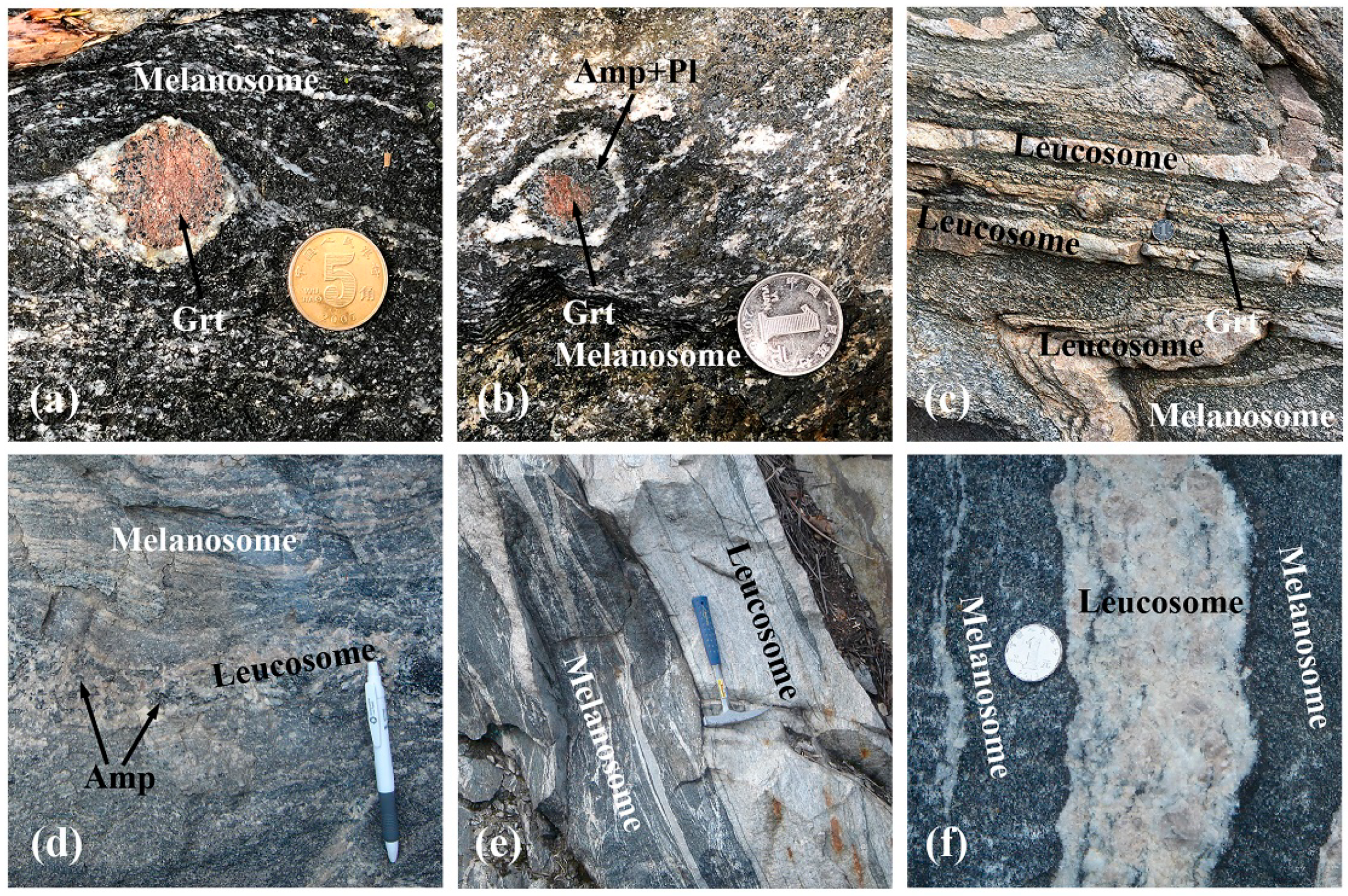
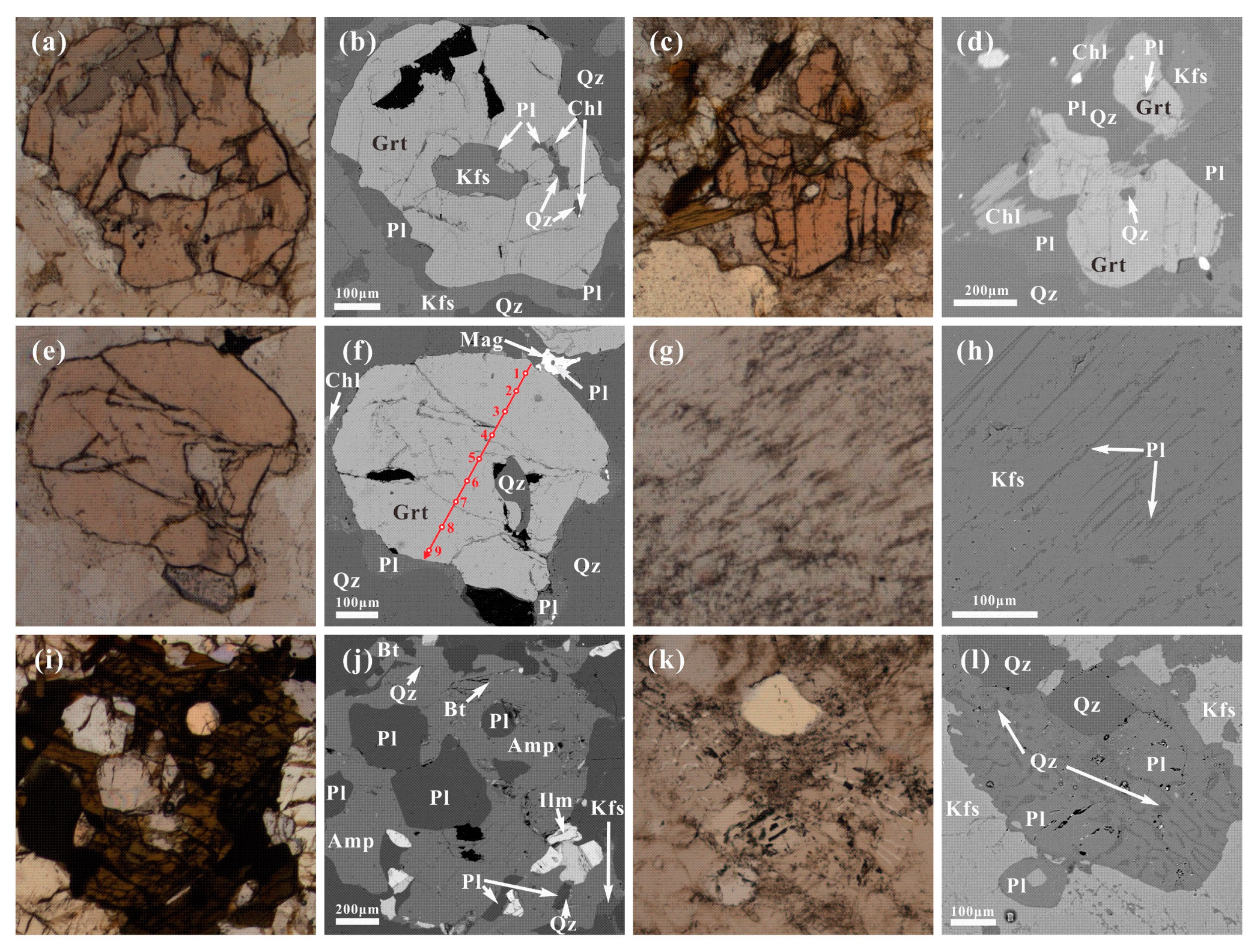
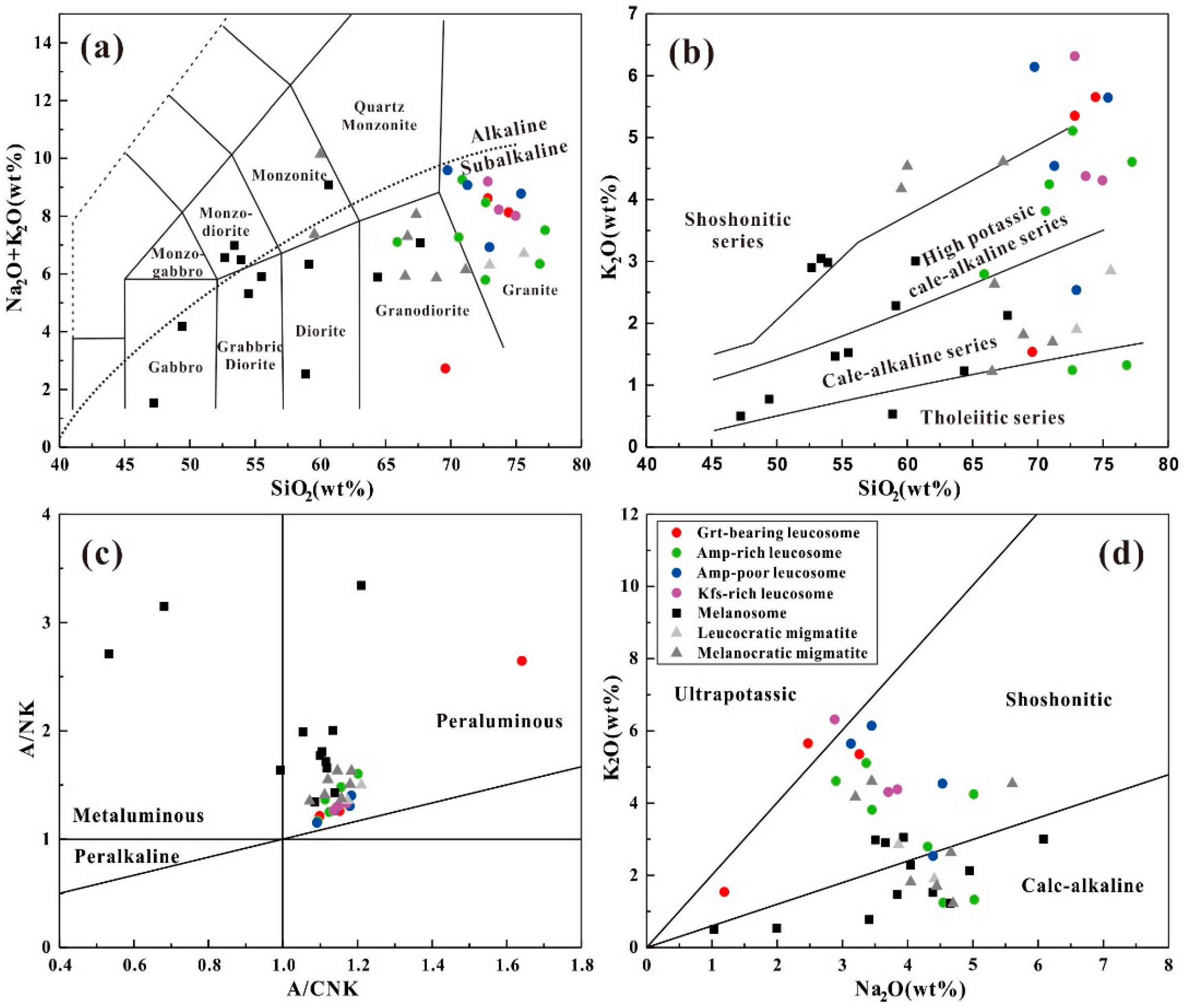
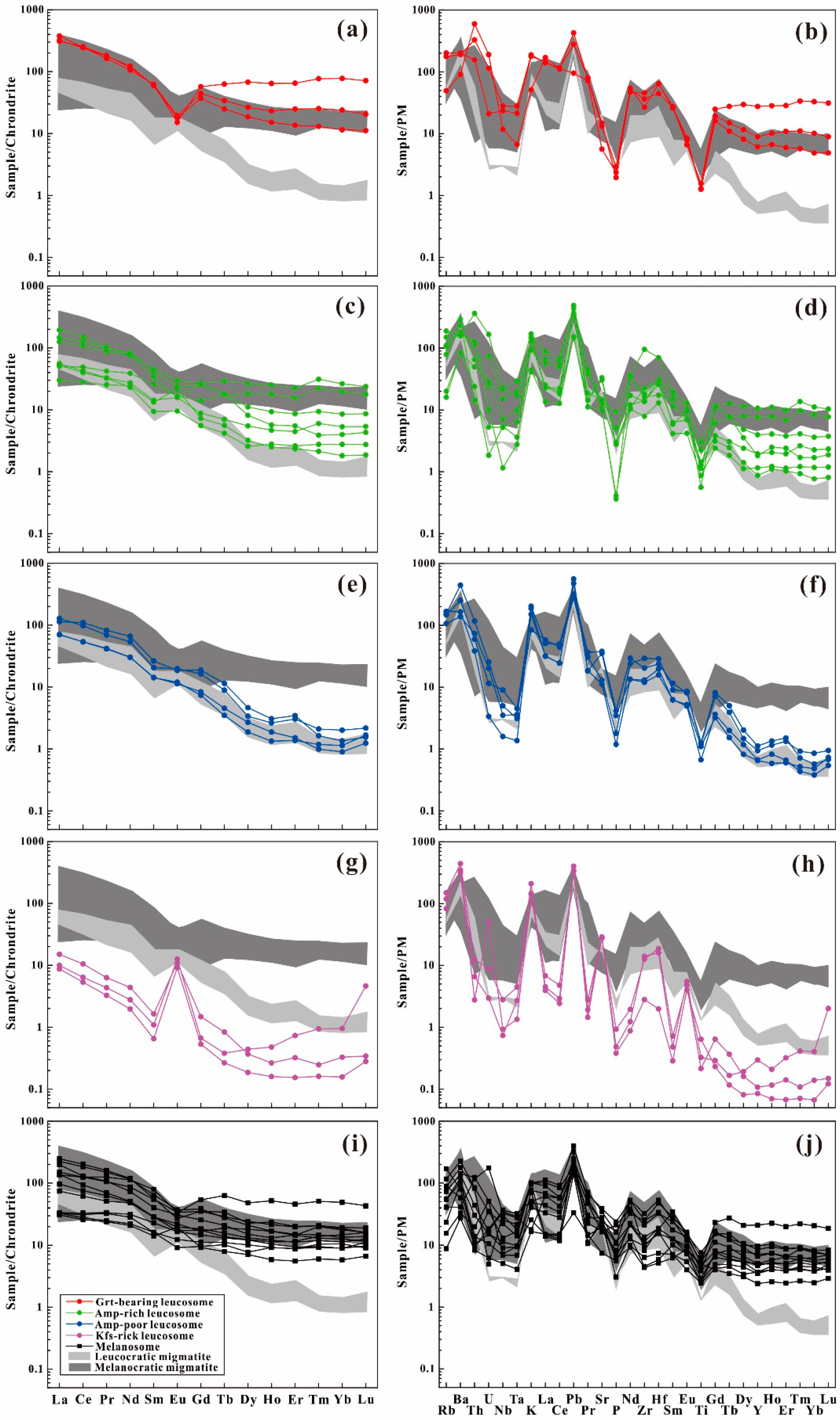
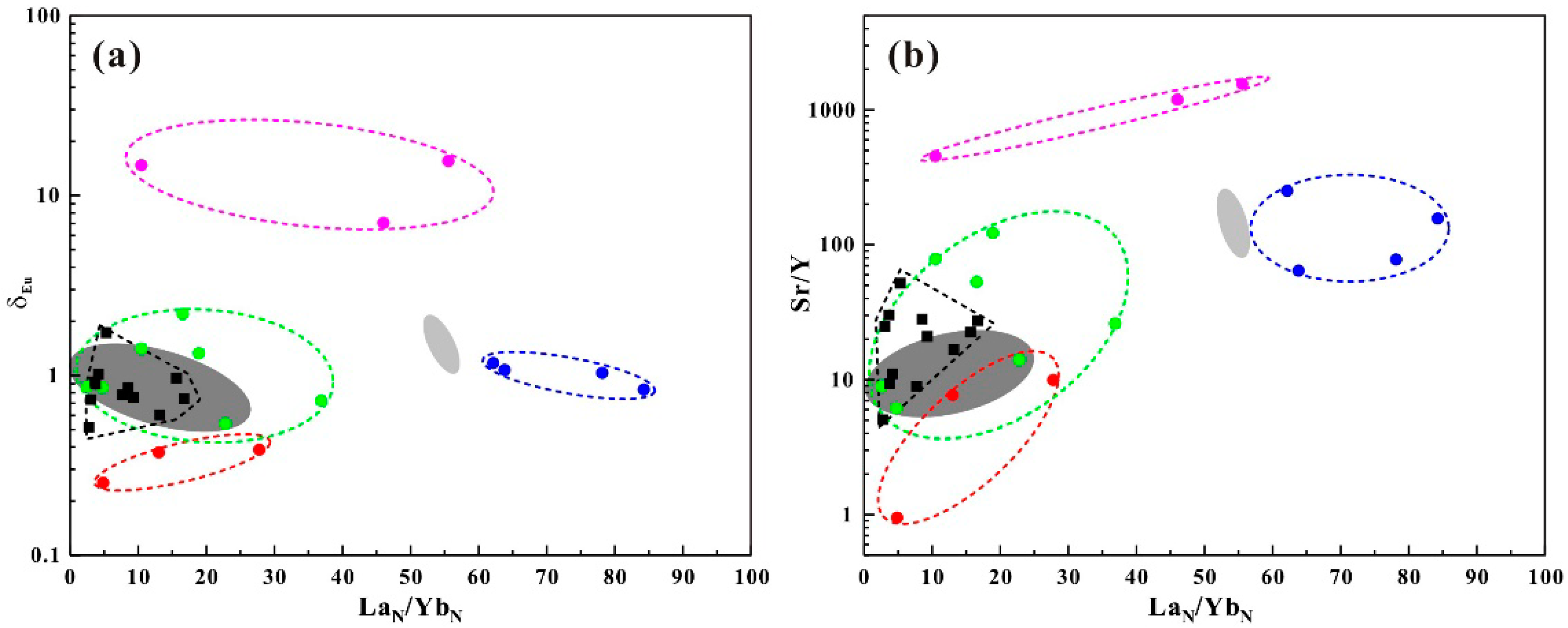
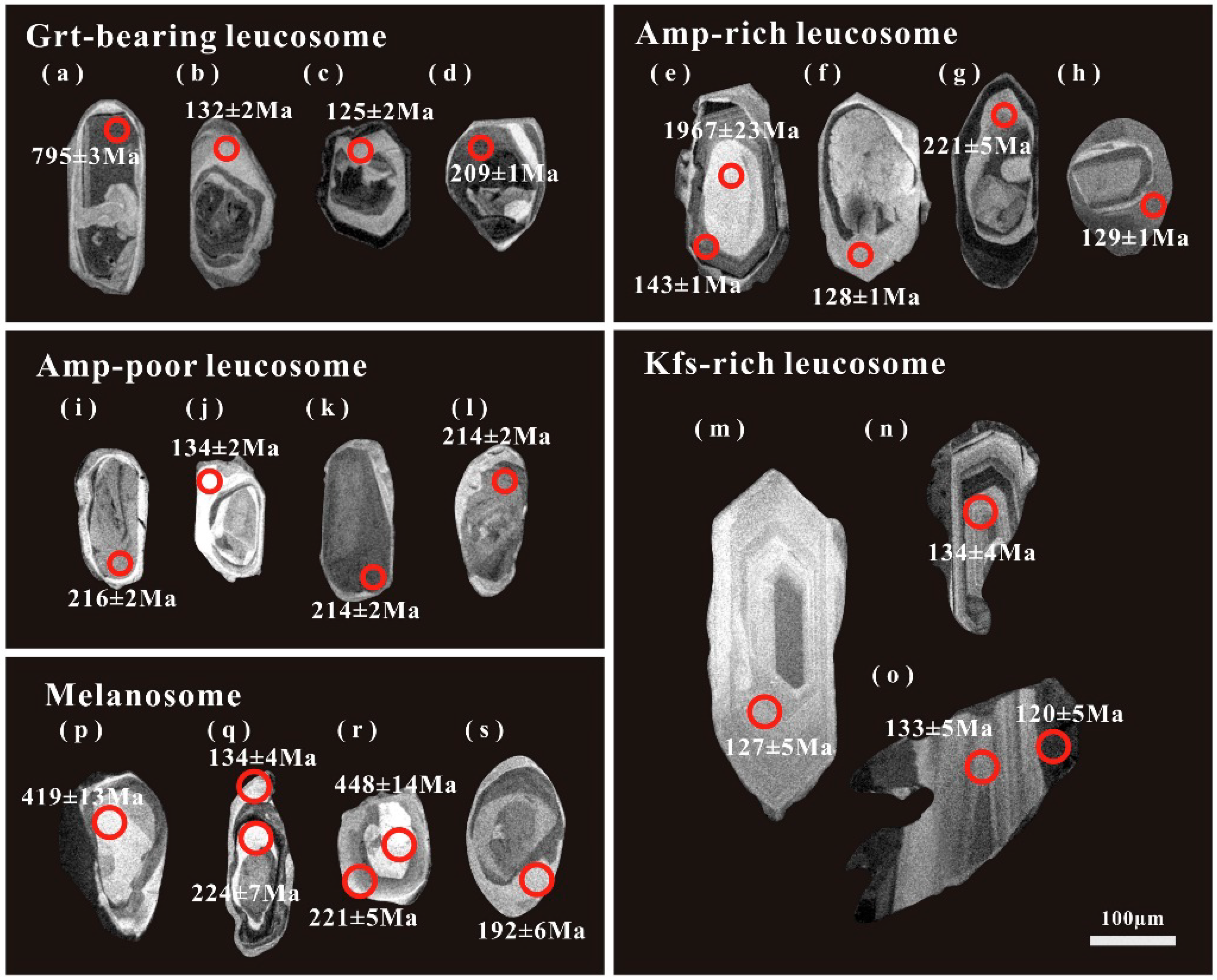


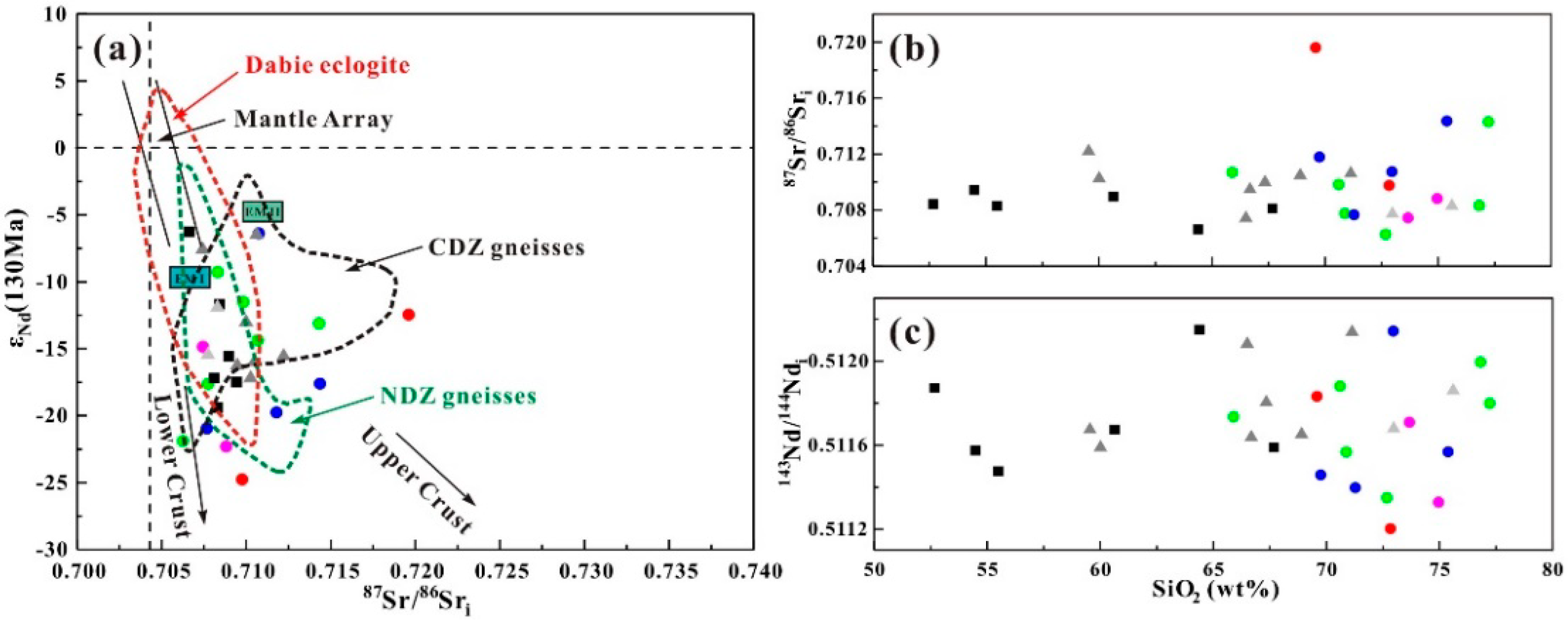
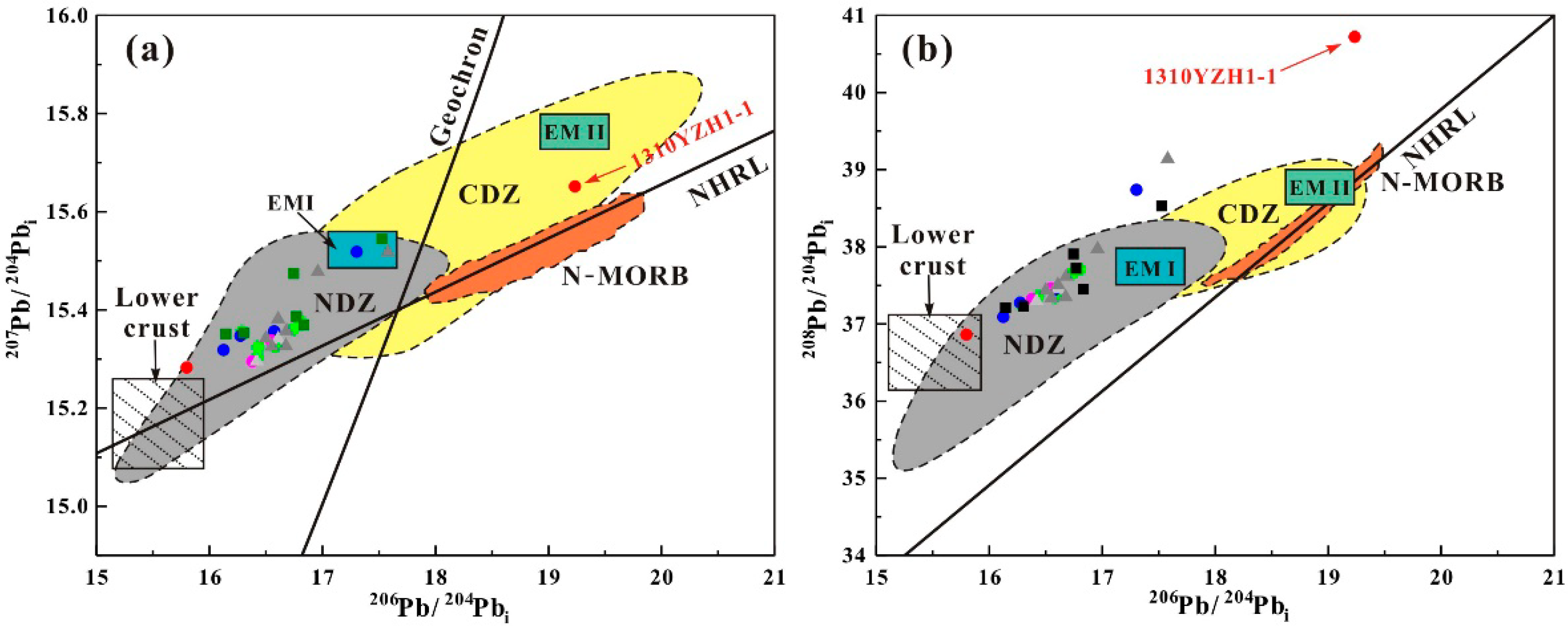
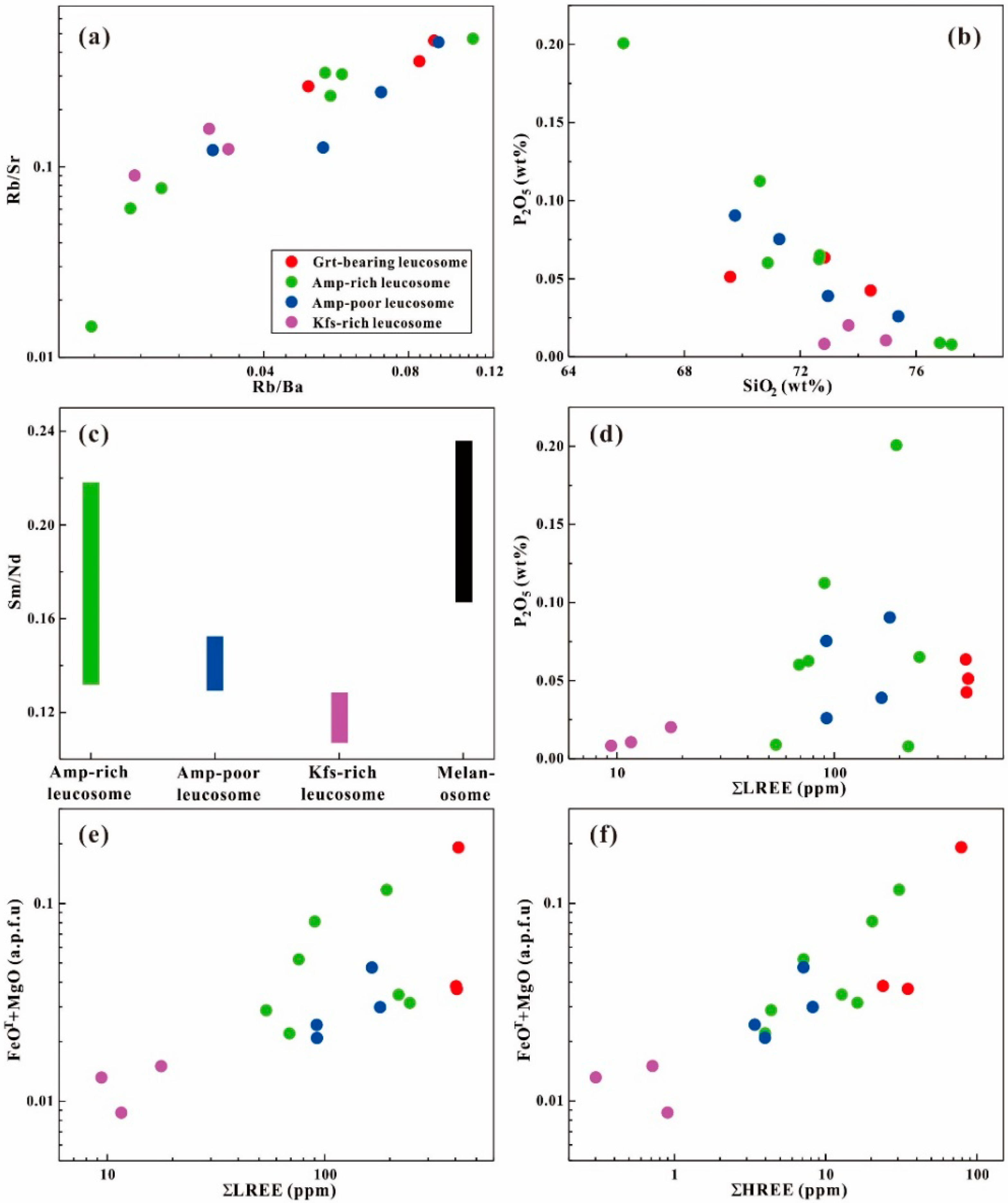
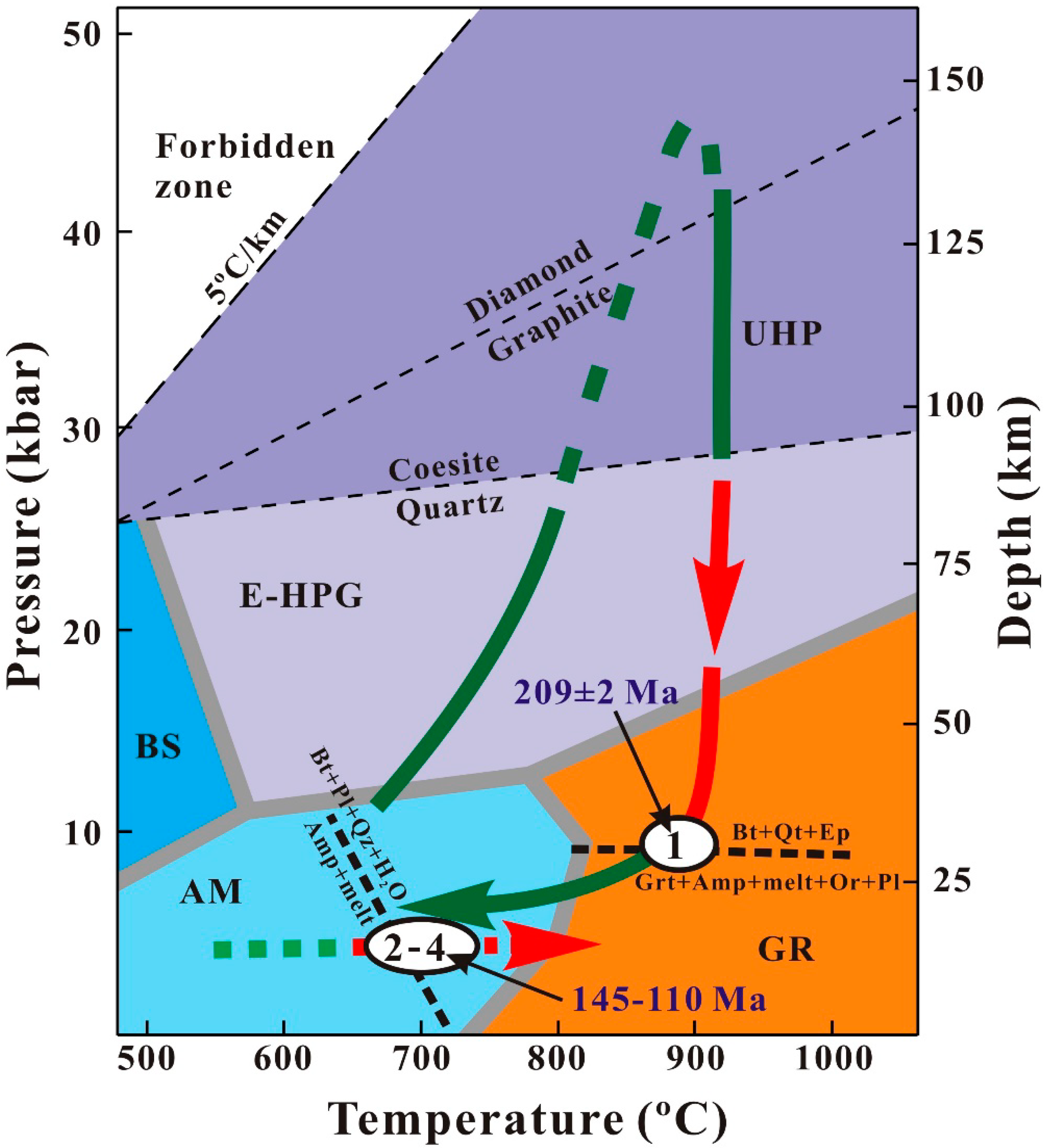
© 2020 by the authors. Licensee MDPI, Basel, Switzerland. This article is an open access article distributed under the terms and conditions of the Creative Commons Attribution (CC BY) license (http://creativecommons.org/licenses/by/4.0/).
Share and Cite
Yang, Y.; Liu, Y.-C.; Li, Y.; Groppo, C.; Rolfo, F. Zircon U-Pb Dating and Petrogenesis of Multiple Episodes of Anatexis in the North Dabie Complex Zone, Central China. Minerals 2020, 10, 618. https://doi.org/10.3390/min10070618
Yang Y, Liu Y-C, Li Y, Groppo C, Rolfo F. Zircon U-Pb Dating and Petrogenesis of Multiple Episodes of Anatexis in the North Dabie Complex Zone, Central China. Minerals. 2020; 10(7):618. https://doi.org/10.3390/min10070618
Chicago/Turabian StyleYang, Yang, Yi-Can Liu, Yang Li, Chiara Groppo, and Franco Rolfo. 2020. "Zircon U-Pb Dating and Petrogenesis of Multiple Episodes of Anatexis in the North Dabie Complex Zone, Central China" Minerals 10, no. 7: 618. https://doi.org/10.3390/min10070618
APA StyleYang, Y., Liu, Y.-C., Li, Y., Groppo, C., & Rolfo, F. (2020). Zircon U-Pb Dating and Petrogenesis of Multiple Episodes of Anatexis in the North Dabie Complex Zone, Central China. Minerals, 10(7), 618. https://doi.org/10.3390/min10070618




